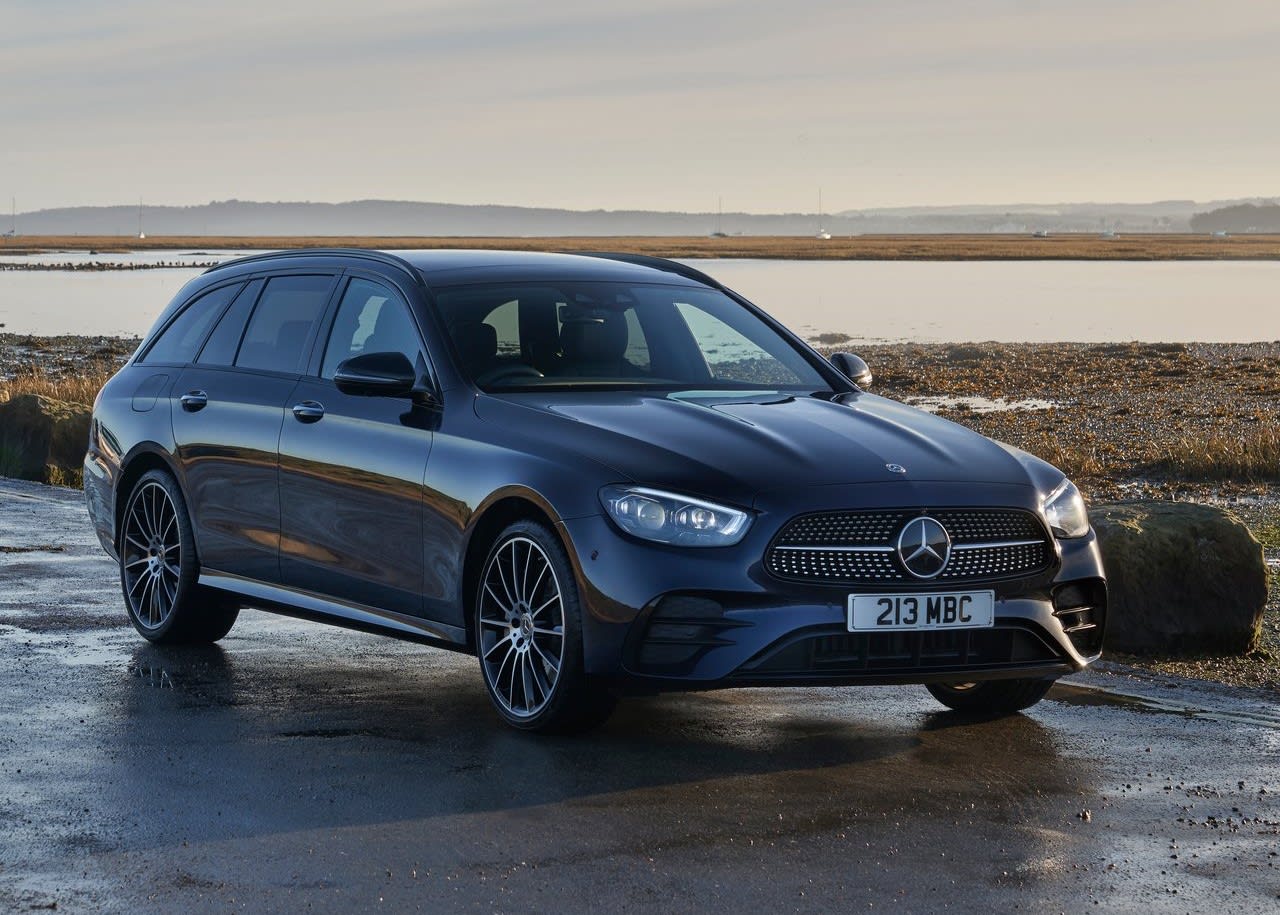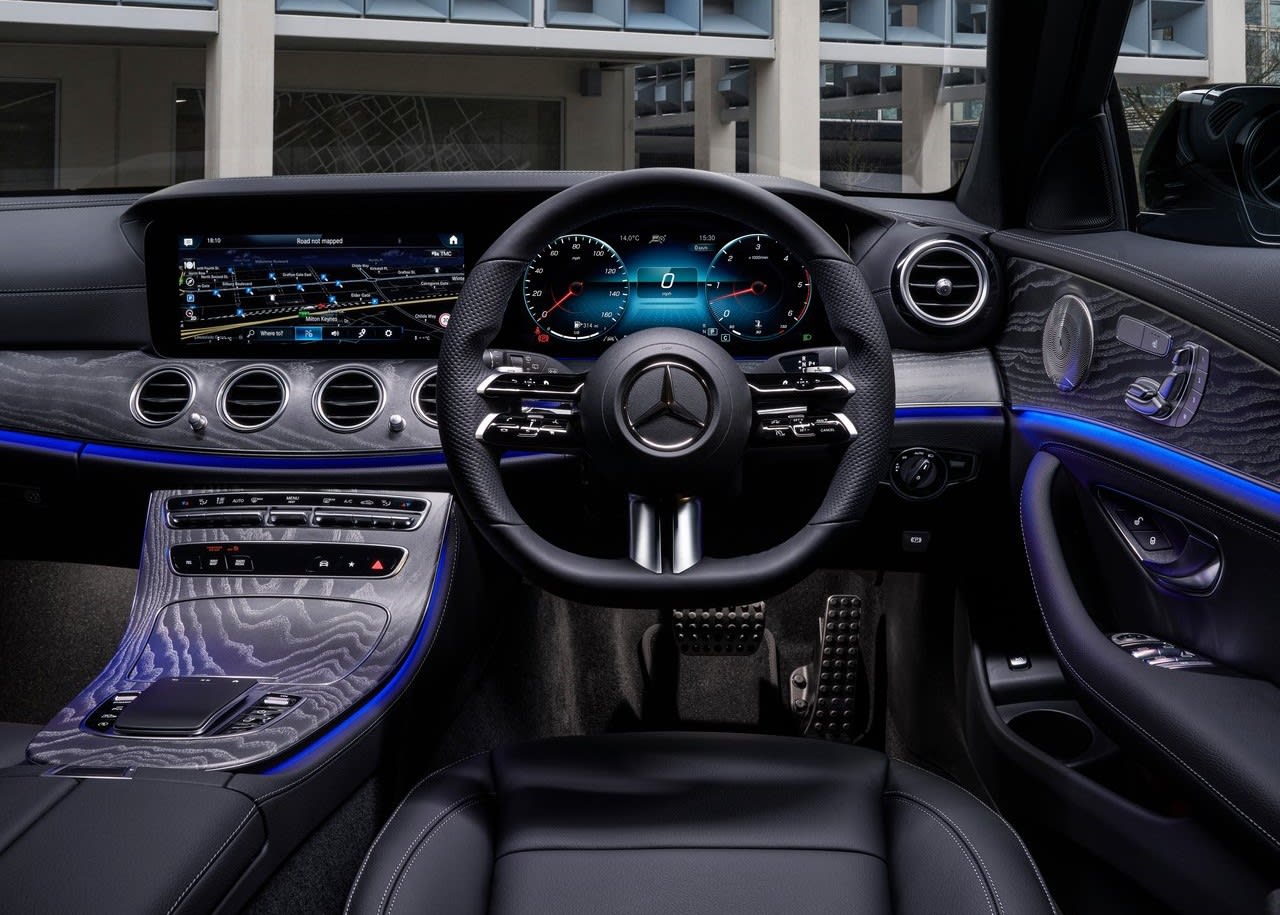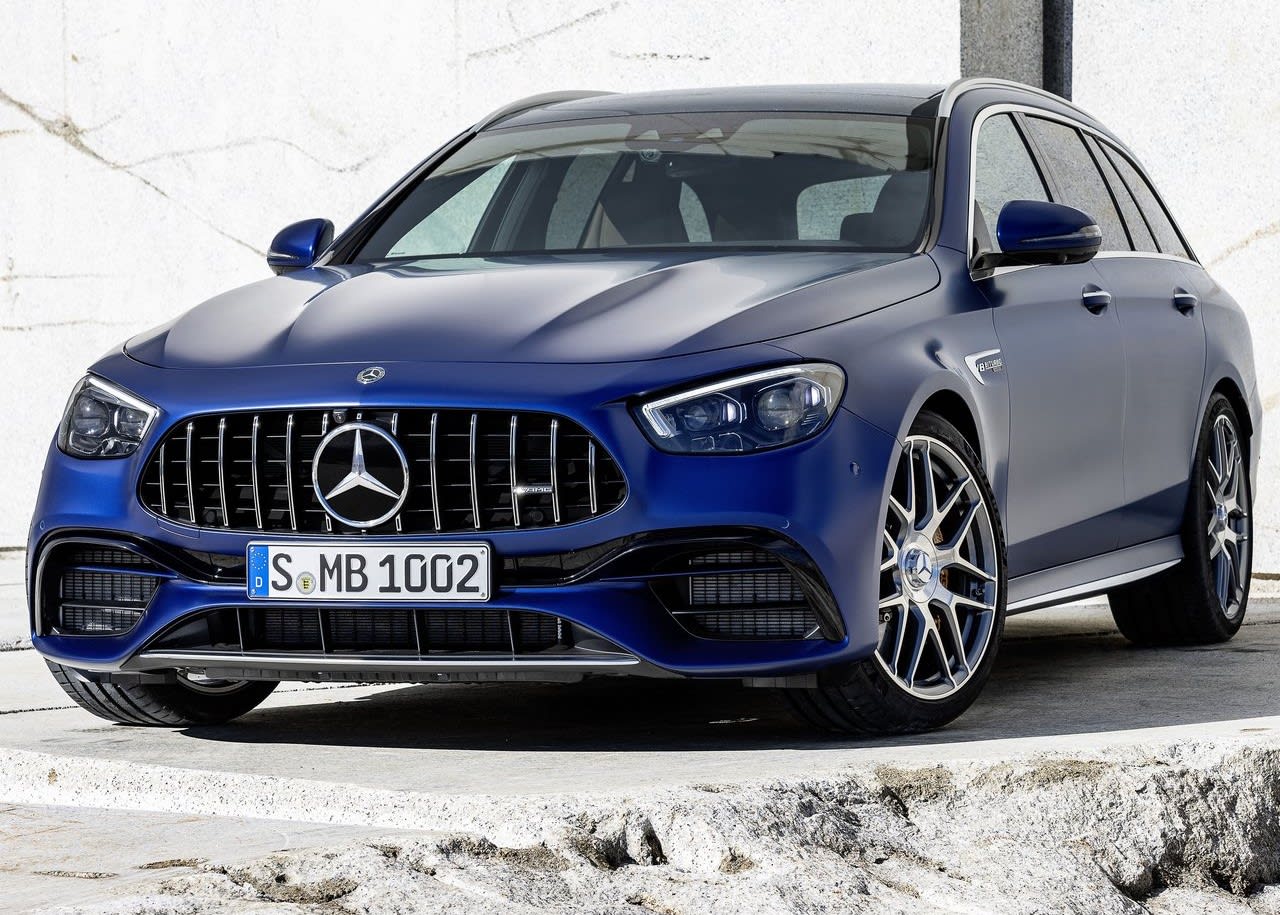
Mercedes-Benz E-Class Estate Review

Introduction
When you’re in the market for an executive car, you choose German, and the Mercedes-Benz E-Class is one of the cars that has driven that trend. A perennial favourite with customers around the world, the big cruiser has made its name with style, quality and performance in equal measure. Mercedes-Benz has occasionally been criticised for so-called ‘Russian doll’ design, with each model simply looking like a bigger or smaller version of another, but there’s no doubting Mercedes’ designers know how to style a car.
This has to be one of the best looking estate cars out there. It’s also one of the most capable.
Review Sections
Select's rating score* - 4.2 / 5
At a Glance
Each of the big German brands has carved out its own niche in the executive estate arena. The BMW 5 Series Touring is the car you choose for driving dynamics, while the Audi A6 is for those who like technology and impeccable cabin quality. The Mercedes-Benz E-Class, however, is the car for people who like comfort and style. A silky ride, economical engines and a timeless, classy look make this one of the forerunners in its field.
Even the entry-level Sport versions are well equipped, with leather upholstery, 17-inch alloy wheels and two digital displays that span the dashboard to create this high-tech widescreen effect. Move up the AMG Line range and you add a few goodies and some sportier styling, but the Sport is all you really need. It’s just a shame the engine range is a bit mean.

At the top of the tree are the AMG 53 and AMG 63 S models, which up the ante with performance-orientated features and equipment, as well as huge six- and eight-cylinder engines that threaten to chew you up and spit you out. If you like your estate cars with a bit of bite, these are for you.
Key Features
A real highlight of the E-Class experience is the double widescreen digital displays that seem to sweep across the dashboard. It’s actually made with two screens, which butt up against each other to create this high-resolution swathe across the front of the cabin. Standard across the range, the system can be controlled using little thumb pads on the steering wheel, a laptop-style touchpad on the centre console or the traditional touchscreen method.
It’s always been a swish system, but Mercedes-Benz has perfected the art with its MBUX infotainment setup. You can personalise the lot to your taste, with different display styles for the instrument cluster and artificial intelligence technology that learns your preferences over time. It’ll even adjust the satellite navigation to suit your favoured locations and routes.
Performance & Drive
As is so often the way with cars such as this, the E-Class engine range is fairly large, with a choice of petrol, diesel and plug-in hybrid powertrains. Things kick off with the 200 engine, which is a 2.0-litre petrol with a nine-speed automatic gearbox and 197hp. That’s enough to get the big E-Class Estate from 0-62mph in 7.7 seconds and on to a top speed of 144mph.
Then there’s the 220d diesel, which is a strikingly smooth 2.0-litre engine with 194hp. Like the 200, and indeed every other E-Class, the 220d comes with a nine-speed automatic gearbox, and the performance is very similar to that of the E 200. The 0-62mph sprint takes 7.8 seconds, while the top speed is 142mph.
Climb the range further and you come to the 300d, which is another 2.0-litre diesel engine, although this one comes with four-wheel drive, rather than the rear-wheel drive system found in lowlier models. With 265hp, it’s capable of getting from 0-62mph in 6.6 seconds before accelerating on to 155mph.

That is not to be confused with the 300de, which is a diesel plug-in hybrid. That in itself is a rarity, but it makes perfect sense when you think about it. On long journeys, you get a frugal 2.0-litre diesel engine, while the electric motor is used on shorter trips, keeping emissions down in urban environments. Put your foot down, though, and you get the combined 306hp might of the two motors, allowing you to accelerate from 0-62mph in six seconds and reaching 146mph at the top end.
Also representing diesel in the E-Class range is the 400d – a 3.0-litre mild-hybrid straight-six engine, which is silky smooth and impressively quiet. Powering all four wheels, the engine churns out 330hp, getting you to 62mph in 5.3 seconds before hitting a 155mph top speed.
If you’re buying a big estate car because you want to go fast on race tracks and B-roads, then the E-Class probably isn’t for you – at least not unless you go for one of the Mercedes-AMG models (more about those in a moment). If you’re sticking with a mid-range petrol or diesel version, you’ll find the BMW 5 Series a slightly sharper thing to drive.
It isn’t bad, by any stretch of the imagination; the rear-drive layout means it’s better balanced than an Audi A6, but the Jaguar XF and BMW 5 Series are just a bit more agile in the corners. That said, you will find the E-Class among the comfiest and most soothing long-distance cruisers on the market, with soft suspension that soaks up all the lumps and bumps British roads tend to throw at you.
Should you brave one of the AMG models – either the 53 or the 63 S – then you can forget the last couple of paragraphs. The AMG cars, and the 63 S in particular, are absolute hooligans, with vast amounts of power on tap and outrageous performance. Both handle sweetly, but lose some ride comfort as a result, while the immense power means the 63 S can be something of a handful when you’re pushing it.

For those who like their facts and figures, the 53 comes with a 3.0-litre mild-hybrid motor whole the 63 S has a 4.0-litre V8. Both come with four-wheel drive and a nine-speed automatic gearbox, but the former gets 435hp, while the latter boasts a massive 612hp. The 0-62mph times stand at 4.5 seconds and 3.5 seconds respectively, and though the 53 is limited to 155mph, the 63 S manages 180mph.
Running costs
With mild-hybrid technology in the 200, 300d and 400d engines, as well as the AMG 53, it’s fairly easy to find an economical E-Class. The 220d is going to be the easiest on fuel on a long run, with claimed economy of up to around 50mpg, while the 300d isn’t too far behind. Even the 400d will manage up to about 40mpg – just slightly more than the much less powerful 200 petrol engine.
But on paper, the economy master is the 300de. That plug-in hybrid will manage around 200mpg on the official economy test, although that assumes you charge it regularly at home and do mostly short journeys in the week. With a parsimonious diesel engine there to step in on long journeys or once the battery has exhausted its range of 27-32 miles, the 300de will still only sip fuel when the engine is running. If your lifestyle suits that powertrain, it’ll save you plenty of money.
Emissions
If you’re looking for an E-Class company car, the 300de has to be the weapon of choice. The electric motor means it emits 36g of carbon dioxide per kilometre on the official economy test. That puts it well down in the low company car tax brackets, saving you a fortune compared with the equivalent diesel version.
But while that may be the only choice for company car drivers, those with a purely environmental conscience might want to think a bit deeper. If a 300de doesn’t suit your needs, you might be better off with a 220d or a 300d, both of which will be hugely economical – and therefore less polluting – than some other models.

And if you’re worried about whether a diesel engine will kill polar bears, just remember modern diesel engines are incredibly clean. ADAC, the German equivalent of the AA, tested a diesel version of the smaller C-Class and found it emitted absolutely no nitrogen oxide whatsoever. Maybe it’s time to let ‘dirty’ diesel in from the cold.
Interior
This is one of the E-Class’ key selling points, with a super stylish and modern interior, despite the basic design being five years old. The car has developed slightly since its launch in 2016, but the huge widescreen infotainment display and curvy, expansive dashboard still look bang up to date. It’s one of those cars that won’t age badly at all.
That’s partly because it’s so well put together. You expect a Mercedes to be well built, but the way things fit together and the way the switchgear feels is very good – certainly on a par with BMW. Audi, though, has got this cabin quality thing nailed, and the A6 somehow manages to feel even more solid.

But the Audi isn’t as good to look at inside, whereas the Mercedes comes with swathes of wood on the dash (carbon fibre if you go for the AMG 53 or 63 S) and plush leather everywhere. If you wanted to define how an executive car interior should look, this is it.
Technology
Although this has been a weak spot for Mercedes of late, the German company is beginning to up its game. The latest-generation MBUX system (Mercedes-Benz User Experience, if you were wondering) is really very good, with clear, high-definition graphics and big screens that somehow make the displays feel less fussy.
You have a plethora of ways available to control the system, with a touchscreen, laptop-style touchpad and even some touch-sensitive thumb pads on the steering wheel. You can use your voice too, although that’s a bit of a gimmick; you aren’t going to use it on a daily basis.

Less of a gimmick is the augmented reality navigation system available on higher-end models. That uses camera technology to place directions on an image of the road ahead, showing you exactly where to turn off and which road to take. It’s a really good idea.
If we’re honest, though, you’re probably going to spend most of your time driving with either Android Auto or Apple CarPlay connected up. Which you use will depend on your choice of smartphone, but both essentially allow you to use apps such as Spotify and Google Maps using the in-car entertainment screen. It’s a bit of a necessity for some cars with less intuitive infotainment systems, and although that isn’t the case here, it’ll probably become your go-to method of navigation.
Practicality & Boot Space
Let’s be honest, nobody leases an estate car because it’s cool. It might be a looker and it might be fast, but even the E 63 S is there for people who just want a bit more space. Fortunately, the E-Class delivers with a 640-litre load bay that’s bigger than that of an Audi A6 or a BMW 5 Series Touring. Just be careful, though, because the plug-in hybrid gubbins of the 300de cuts into that boot space quite dramatically, leaving just 480 litres of space.
Fold the rear seats down and you get even more room. You can free up more than 1,600 litres of space in the 300de, while other models will offer more than 1,800 litres of space with the rear seats collapsed.

Space in the cabin is generally good too, although the rear seats aren’t quite as capacious as some cars in this class. Nevertheless, the E-Class is perfectly comfortable for four adults on a long trip, and kids will have bags of space to stretch out. Seating three grown-ups across the rear might be a little cramped, but perfectly survivable for a short lunchtime jaunt to your local cafe.
Climb high enough up the range and you’ll benefit from other practical additions, including an electronically operated tailgate and clever memory seats that can be preset for different drivers. No need to worry about whether your excessively tall/short partner has moved the seats – just press a button and it all comes back to wherever you left it.
Safety
If you ask Euro NCAP, the independent crash test organisation, they’ll tell you the E-Class is among the safest cars in its class. Admittedly, the company tested the car before its mid-life facelift, but although details have changed, the five-star rating is still valid for what is essentially the same car underneath.
And that rating should help put your mind at ease, because the E-Class achieved a staggering 95% score for adult occupant protection and an equally impressive 90% score for child occupant protection. If you want an estate car that’s going to keep you and your family as safe as houses, you can’t do much better than this.
Hopefully things will never get to that point, because the E-Class also comes with a whole host of safety gadgets designed to help keep you from ever having accidents in the first place. All the usual gizmos, including autonomous emergency braking and blind-spot monitoring, are all present and correct, even in entry-level cars.
Like all Mercedes products, the E-Class also comes with one of the best reversing cameras in the business. Where so many produce a grainy image that wouldn’t look out of place on a dodgy TV in 1976, the Mercedes system produces a gorgeous, pin-sharp image. Okay, the gorgeous bit might depend on where you are in the world, but the clarity of the image doesn’t change.
Options
The E-Class range is pretty sizeable, and that means picking the perfect car isn’t as easy as it should be. So let us guide you through.
Your common-or-garden, base-spec E-Class is the Sport, but don’t be put off by its position at the foot of the range. You still get leather upholstery, 17-inch alloy wheels and heated front seats, not to mention the 180-degree reversing camera, heated front seats and the aforementioned MBUX infotainment system. But although you get all that kit, you have a choice of just two engines: the 200 petrol engine and the 220d diesel.
The next rung on the E-Class ladder is the AMG Line, which gives you much more choice in the engine bay. You can have your pick of the engines, except for the 400d diesel and the two AMG powertrains. You also get some bigger, sportier alloy wheels, an AMG bodykit and three-zone climate control, as well as black roof lining.
Or you can have the AMG Line Edition, which goes without the three-zone climate control and is available solely with the 300de plug-in hybrid powertrain.

Step further up the range and you come to the AMG Line Premium, which includes 19-inch alloy wheels (although the hybrid sticks with the AMG Line’s 18-inch rims), a power-operated tailgate and a 360-degree parking camera. Or you can move up to the AMG Line Night Edition Premium Plus, which includes 20-inch alloys (unless you go for the hybrid), a panoramic glass sunroof and some black trim around the windows, door mirrors and grille. It also gets a high-end Burmester sound system as standard.
Finally, the AMG models come with their own unique specifications. The 53 comes in ‘Premium’ guise as standard, giving it 19-inch alloy wheels, an even more aggressive AMG bodykit that includes a bolder grille, and an electrically operated tailgate. Air suspension is also fitted, while the cabin is adorned with an AMG steering wheel and three-zone climate control. Alternatively, you can have the E 53 and E 63 S in Night Edition Premium Plus guise, earning you 20-inch alloy wheels, glossy black exterior trim and the Burmester sound system.
Rival Cars
Among the E-Class’ biggest competitors are its compatriots, the BMW 5 Series Touring and the Audi A6 Avant. In simple terms, all three are big, well-built and well equipped estate cars with plenty of luxury and – let’s be honest here – a fair bit of badge snobbery attached.
But when you dig deeper, you’ll find a few subtle differences that set these cars apart. Let’s start with the BMW, which trumps both the Audi and the Mercedes-Benz in the handling stakes. With staggering poise, it knocks the spots off its rivals on a track or back road, but it lags slightly behind the Mercedes when it comes to long-distance motorway comfort. And although both the 5 Series and E-Class are solid, well built things, the A6 takes quality to another level.
That short interlude kind of sets the scene for comparisons between the big German luxury cars – you can spend all day arguing their myriad merits, but choosing the one for you will purely come down to personal preference.
Perhaps then, we should look at some other cars that put the cat among the pigeons, and we’ll start close to home. The Jaguar XF Sportbrake is up there with the prettiest cars in this segment, and the looks are backed up by impressive handling. It isn’t quite as sharp as the BMW, but it’s more entertaining than an E-Class or an A6. And although Jaguar has begun its return to the timeless wood-and-leather luxury of old, it isn’t quite as nice inside as you might be hoping.
For real style, you might want to consider the oh-so-Swedish Volvo V90. Although not quite as good looking as the smaller V60, the big Volvo estate is a looker, and the interior is gorgeous. It’s like sitting in a boutique Swedish ski chalet. Just watch out for the engine range, because Volvo hasn’t gone down the six- or eight-cylinder route, and that makes those motors feel as though they’re working harder than their bigger German rivals.
Verdict & Next Steps
With style, sophistication and a beautifully supple ride, the E-Class makes a great case for itself, despite the quality of its rivals. Yes, the BMW 5 Series Touring and Audi A6 Avant are great cars, but so is the Merc. In truth, these three heavyweights are a match for each other in pretty much every area, but the E-Class noses ahead on the ride and design fronts. As a result, if you want a roomy, luxurious estate car, the E-Class simply has to be on your shortlist.
Where to next?
View latest Mercedes-Benz E-Class leasing deals - guide price from £377.99 per month inc VAT**
Looking for a great deal? Check out our incredible range of car lease deals
New luxury estate car? Read our latest Reviews and find the right model for you
Want to know more about leasing? Take a look at our comprehensive Leasing Guides
Interested in everything motoring? Why not catch up on all the latest Car Leasing News.
*Score based on Select’s unique meta score analysis, taking into account the UK’s top five leading independent car website reviews of the Mercedes-Benz E-Class Estate
**Correct as of 13/05/2021. Based on 9 months initial payment, 8,000 miles over a 48 month lease. Initial payment equivalent to 9 monthly payments or £3401.89 Ts and Cs apply. Credit is subject to status.



















